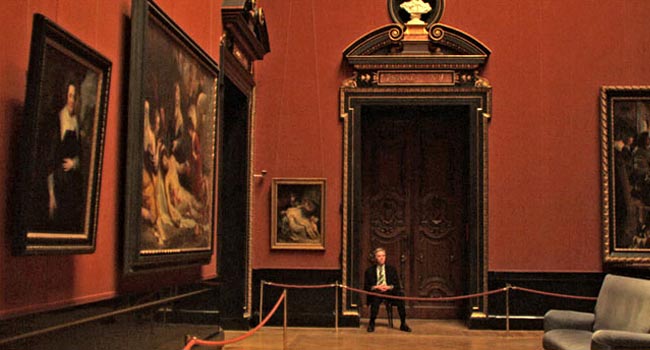
Museum Hours assumes a unique shape that's as fascinating as the paintings Cohen adores with his camera.

Museum Hours assumes a unique shape that's as fascinating as the paintings Cohen adores with his camera.
In director Jem Cohen’s Museum Hours, a late-middle-aged Viennese museum patrolman and a Canadian tourist share a ruminative brief encounter, like an older, wiser, more meditative version of Sofia Coppola’s Lost in Translation or Richard Linklater’s Before series. The title refers to Vienna’s Kunsthistorisches Museum, where the two meet and where most of the film is set. (Man, “Kunsthistorisches” would have been a great movie title, wouldn’t it?) As the fast friends share illuminating existential conversations and peer the gorgeous works that populate the museum’s gilded walls, the film drifts into non-fictional, documentary style scenes, and assumes a unique shape that’s as fascinating as the paintings Cohen adores with his camera.
The guard, Johann (Bobby Sommer), bears his satisfaction with his profession on his quietly contented face, describing the gig as “not bad at all.” When Anne (Margaret O’Hara)–a disoriented Canadian tourist who’s visiting a comatose distant relative–runs into Johann at the Museum, he goes above and beyond his patrolman duties and, in a purely platonic gesture, shows her around the city. Sommer is charismatic and charming in the most understated way possible, while O’Hara pales in comparison, coming across as an afterthought. Still, their companionship is sweet. Their existential, art-flavored chats feel a lot like the intellectual exchanges shared by Juliette Binoche and William Shimell in Abbas Kiarostami’s Certified Copy, but with far less bite. If Certified Copy is an older, more experimental version of the Before series, Museum Hours is an even older, even more experimental rendition of the touristic walk-and-talk sub-genre.

The extra layer of experimentation is represented by documentary style sections in which a museum guide lectures about the finer details of Brueghel paintings and other works (immaculately lit and captured by Cohen, who makes the inanimate artworks look spectacularly alive). Cohen perhaps drifts in and out of these non-fictional segments a bit too listlessly, but the unpredictability of these transitions keeps you on your toes, and their effect on the experience is ultimately pleasurable and absorbing.
Everything in the film–from the intimate interiors, to the postcard-pretty exteriors, to the brilliantly photographed paintings–is a feast for the eyes, and the objects and environments deserve all the effort Cohen and company put into making the film look so masterfully rich and exquisite.
The film’s key message–that earnest, close observation of art can often magnify its pleasures–is a powerful one, and gratifyingly meta at the end of the day. Cohen examines the skill of looking–looking at art, looking at film, looking at the world around you. He observes the art, and we observe his art, watching intently as he films intently. So often we as moviegoers enter a theater with a sense of entitlement, sitting in our seats with crossed arms, stubbornly waiting for the filmmaker to grab us by the cheeks and lead us through the story. Sometimes, as is mentioned in the film, an artist beseeches us to meet him or her halfway, to participate in the experience and invest a bit of our energy. Museum Hours is this kind of film where you feel a wonderful sort of partnership with the filmmaker, if you’re willing to engage.